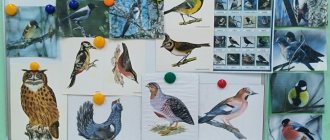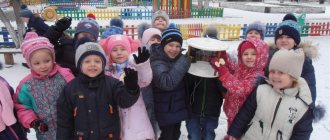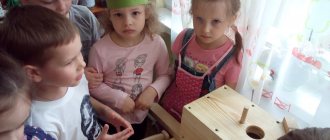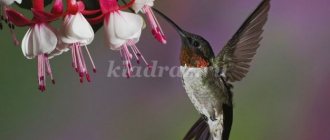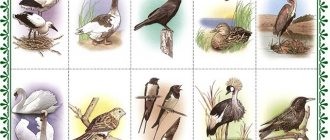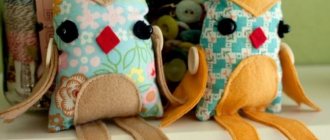Weekly calendar plan on the topic “Wintering birds” for preschool educational institutions
Topic: “Wintering birds”
Monday.
Morning.
1. Morning conversations with children. Topic: “Wintering birds.” Goal: To consolidate the concept of “wintering” birds. Give an idea of the types of food of wintering birds. Develop a desire to take care of wintering birds.
2. Self-service “Drying the mittens.” Teach to take care of your health and clothing.
3. Speech games and exercises: “Count” the agreement of nouns. with the numeral, “Whose beak, whose paws?” formation of possessive adjectives
4. Canteen duty. Strengthen children's ability to set the table.
5. D/i “Find the bird’s shadow”, “Geometric mosaic”. (assembling a bullfinch from geometric shapes)
6. Develop fine motor skills. “Laying out bird figures from beans.”
GCD 1. Speech therapy
2. H.E.R. Modeling "
Bullfinches on branches
»
Program tasks:
Expand children's understanding of wintering birds. Teach children to convey their impressions and observations of living nature in art activities through relief modeling. Continue to teach children to depict birds (bullfinches, conveying the features of appearance (bird structure, color). Reinforce sculpting techniques: rolling, flattening, smearing, dividing plasticine into parts using stacks. Develop children's creative abilities.
Material:
blue colored cardboard (light blue, plasticine, modeling boards, stacks, hand napkins, illustrations of bullfinches.
Dictionary:
notch, arc, relief.
Methodical techniques:
org. moment - d/i “Flies - does not fly”, “Find out by description”, riddle about the bullfinch, physical exercise “Birds”, explanations from the teacher, demonstration of the method of sculpting, independent and ind. work, result.
3. H.E.R. Musical
Walk:
1. Observation of snow. D/U “What kind of snow?” Looking at snow under a magnifying glass
2. Labor activity “Hanging up feeders”, “Feeding birds”. Teach children that feeding birds in winter is necessary because... the birds are dying of hunger.
3. Outdoor games “Kite and hen”. Goals: continue to teach how to follow the rules of the game; intensify physical activity.
4. P/i “Sparrows and the cat.” Goal: to improve agility and running speed.
5. Fun games: “Let's go down the hill” Develop general endurance, the ability to interact with peers, give in, help a friend.
2nd floor day.
1. S/r game - “Veterinary Clinic”. Improving the ability to independently create a game environment for a planned plot. Formation of valuable moral feelings (humanity, love, sympathy, etc.).
2. Fill out the observation calendar: “What birds were seen on the site during the walk?” Objectives: to strengthen children’s ability to work with the nature calendar, to consolidate knowledge about wintering birds.
3. Folk games “Does it fly or not? (naming birds) goal: to develop attention and memory.
4. Work on developing fine motor skills “cutting out a snowflake from napkins.” Develop attention.
5. Reading thin. lit. “Woodpecker” K. D. Ushinsky. Objectives: to cultivate an emotional and figurative perception of works, to teach to understand figurative expressions, to lead to an understanding of the genre features of the poem.
Tuesday
Morning
1. Conversation with children “How our feathered friends live in winter.” Goal: to create a desire to help our feathered friends during the winter lack of food.
2. Printed board game “Cut pictures. Bird" goal: continue to practice the ability to assemble puzzles.
3. Involve children in the design of the three-dimensional panel “Wintering Birds”. Goal: to practice the ability to cut out silhouettes, to consolidate knowledge about wintering birds.
4. Canteen duty. Goal: teach children to set the tables for breakfast on their own.
5. Exercise children in the ability to draw a bird according to a sequential drawing scheme.
6. Didactic game “Recognize the bird by description.” Goal: to consolidate the ability to recognize a bird by its characteristic features.
7. Didactic game “Chain”. Goal: to form ideas about birds as living organisms (they move, fly, swim, eat, breathe, reproduce).
GCD 1. Speech therapy
2. P.R. FEMP "
Length of segments
»
Program tasks:
Continue to learn how to compose and solve arithmetic problems involving addition and subtraction, strengthen the ability to measure segments using a ruler, develop the ability to navigate on a sheet of paper in a square, develop attention, memory, and logical thinking.
Didactic visual material
: a bucket with tinted water, 7 blue circles, strips of different lengths, a ruler, counting sticks of two colors, checkered notebooks with a sample pattern, pencils, pictures of children involved in various types of winter sports, having 5 differences (2 pcs. for each child).
Dictionary:
line, centimeter, measurement.
Methodical techniques:
org. moment “Days of the week”, game exercise “Building an ice fortress”, measuring the length of paths using a ruler, game exercise “Drawing patterns”, physical exercise, d/ and “Find 5 differences”, total.
3. F.R. Physical education No. 33
II
H.E.R.
Drawing “ Birds in the trees
”
(team work)
Software tasks:
using an unconventional drawing technique (palms) to arouse interest in visual arts. To develop the ability to use unconventional drawing, to train children in drawing with their palms and fingers (print). Develop the ability to independently choose the color scheme of paints to create an expressive image. To foster independence, confidence, a desire to work in pairs, and a positive attitude towards the results of one’s own creativity and the creativity of other children. Develop aesthetic taste, creativity in creating an artistic image, cultivate love and care for birds.
Dictionary:
breast, restless, nimble.
Material:
pictures of wintering birds, brushes, paints, napkins, panels of forests with trees.
Methodical techniques:
org. moment - riddles about birds, teacher's story, looking at pictures, showing how to draw, finger gymnastics, reminding how to draw, independent and other. work, result.
Walk
1. Observing clouds. Invite the children to find a cloud in the sky that looks like a bird, describe this bird, and give it a name. Goal: to develop children's powers of observation, imagination, and fantasy; develop skills in writing a descriptive story.
2. Hanging feeders on tree branches. Putting food into feeders. Goal: to form in children a responsible attitude towards nature, to develop an environmental culture.
3. Work on the site - sweep the paths. Goal: to cultivate the desire to complete the work started.
4. Ind. Job. Exercise children in walking backwards.
2nd floor day.
1. Reading fiction: V. Bianki “Red Hill” (from the collection “Forest Were”) goal: to cultivate moral feelings, retell passages.
2. Learning the breathing exercise “Let’s warm the bird with our breath.” Develop breathing.
3. S/R game “Visiting the Forester” Goal: to consolidate the rules of behavior in the forest through play activities.
4. Modeling “Birds” Purpose: to teach children to convey the figure of a bird, its structure, using a variety of sculpting techniques (pulling, pinching, smoothing, etc.; to develop aesthetic perception.
5. Work in notebooks “Continue the pattern” Purpose: to practice orientation on a sheet of paper in a square
Walk
1. Observing the wind. How does wind affect bird flight? Purpose: to learn to draw conclusions from observations.
2. Invite children to watch birds. What birds fly to our site? Goal: to teach how to correctly identify birds by their appearance, to notice the beauty of birds living nearby. Observe their habits and behavior. Pay attention to the fact that birds live nearby in dreams, they are part of our native nature, Birds are our friends, we must take care of them.
3. Outdoor game “I know five names of birds.” Goal: to develop motor activity in children. To consolidate knowledge of different types of birds.
Wednesday
Morning
1. Conversation with children “Who cares about the birds.” Purpose: to draw children's attention to the fact that in winter birds cannot find food for themselves; they need to be taken care of and fed.
2. P/I “Wintering - migratory.” Goal: develop attention.
3. Didactic game “Who Shouts How.” Goal: to consolidate children's knowledge of how birds call.
4. Examination of the painting “Birds at the Feeder”. Goal: to summarize children’s knowledge about wintering birds and their needs; evoke in children sympathy and a desire to help them.
5. Work in a corner of nature - caring for indoor plants. Purpose: to practice the ability to loosen soil in pots.
6. D/I “Bird's Dining Room” Purpose: to train children in memorizing a poem using a mnemonic table.
7. Introduction to the “Bird” model. Goal: to clarify children’s understanding of the structure of birds. Learn to use the symbolic structure of birds.
GCD 1. Speech therapy
2. S.K.R. life safety fundamentals
"Road signs"
Software tasks:
Consolidating knowledge about information signs, teaching children to distinguish road signs, consolidating children’s knowledge about traffic rules; to cultivate the ability to independently use the acquired knowledge in everyday life, to consolidate children’s knowledge of the rules of the road, to introduce them to the new role of a traffic controller, to cultivate self-control, patience, and attention on the road.
Dictionary:
traffic controller, warning, prohibiting, permitting.
Material:
road signs, baton, police uniform, road sign posters.
Methodical techniques:
org. moment, familiarization with road signs, repetition of traffic rules, d/i “Find the sign”, physical exercise, sr game “Traffic Controller”, summary.
3. H.E.R. Musical
Walk
1. Determine today’s weather with the children. Remember what the weather was like yesterday. Learn to compare, notice changes, learn to plan what they will do on the site depending on the weather.
2. While feeding birds, observe their habits. Ask questions. What birds fly to the feeder? What do birds eat? Which birds like which food? Cultivate observation skills.
3. P/I “Kite and Mother Hen” Exercise children in performing the “side gallop” step.
4. Outdoor game “Fourth odd”. Goal: to develop the ability to classify birds by responding to the teacher’s mistake with certain movements.
5. Conversation “Rules for safe behavior in winter on the site”
6. Offer to sprinkle bird food. Goal: to cultivate a desire to help birds in winter.
2nd floor day.
1. Theatricalization “Where did the sparrow have dinner?” Goal: to practice the ability to imitate the habits of animals, coordinating movements with the text.
2. D/I “Fantastic Bird”. Goal: develop imagination, teach to invent fantastic birds.
3. D/I “Build a bird” Purpose: to exercise the ability to build an image of a bird using geometric shapes.
4. Reading fiction: V. Bianchi “Red Hill” (from the collection “Forest Were”) (continued). Goal: compare passages, develop coherent speech.
5. D/I “Whose tail? Whose beak? Goal: to practice the ability to name birds based on external features.
Walk
1. Observations of the onset of evening, how birds behave when darkness falls.
Purpose: to learn to draw conclusions from observations.
2. Outdoor game “Wolf in the Moat”. Goal: continue to teach how to follow the rules of the game, act (imitate the movements of a wolf and geese) according to the chosen role and text.
Thursday
Morning
1. Conversation with children “Hello, winter-winter” Purpose: to give an idea of winter phenomena that affect the life and behavior of birds.
2. Didactic game “Who can name the most wintering birds.” Goal: to consolidate knowledge about wintering birds.
3. Duty in class. Purpose: to teach how to prepare a workplace for classes.
4. Cutting out images of birds. Purpose: recognize and classify birds, admire their diversity and beauty, skillfully use scissors: cut along the outline of the birds.
5. Working with the model “How we help birds.” Goal: to cultivate an environmental culture - to make children understand how we can contribute to the conservation of nature; teach children to understand the language of symbols, draw conclusions and inferences
6. Sort the plant seeds brought by the children. Goal: to clarify which plant seeds the children brought, and who they will feed with these seeds in the winter.
7. Exercise for fingers to the text of I. Tokmakova’s poem “A Flock of Birds.” Goal: develop fine motor skills, memorize the text of the poem.
GCD 1. Speech therapy
2. P.R. FEMP "
Composition of a number from units
»
Program tasks:
learn to compose and solve arithmetic problems for addition and subtraction, introduce coins in denominations of 1, 2, 5, 10 rubles, their collection and exchange, improve the ability to navigate on a sheet of paper in a square, learn to compose a number from units, develop attention and logical thinking.
Didactic visual material:
cardboard models of coins of different denominations (rubles), cards with numbers, counting sticks, cardboard coins of different denominations (rubles), checkered notebooks with pattern samples, pencils, workbooks.
Dictionary:
coins, bills, rubles, kopecks.
Methodical techniques:
org. moment - “Get organized for the week!”, solving problems of Grandma Riddle, determining the structure of the problem, making up numbers from units, getting to know money, making up a certain amount of money, physical exercise, game exercise “Pattern for Grandma”, summary.
3. H.E.R. Drawing "
Wintering birds
»
Program tasks:
To consolidate children's knowledge about the structure of birds and their appearance; teach children to draw birds step by step; teach children to find distinctive and similar features between a tit, a bullfinch and a sparrow; develop fine motor skills and creativity in children; cultivate a love for birds.
Material and equipment:
didactic game “Wintering or not wintering”; illustrations depicting birds: tit, sparrow, bullfinch; example of a teacher; blue tinted paper with painted branches; simple pencils; watercolor paints.
Dictionary:
sharpening the tips, tubercles, according to the topic.
Methodical techniques:
org. d/i moment “Name the wintering bird”, “They winter - they don’t winter”, riddles, comparison of birds - bullfinch, tit, sparrow, finger gymnastics “Chicks”, reminder and partial demonstration of the drawing method, independent and ind. work, result.
Physical education in games on a walk No. 17.
Walk
1. Observation of birds flying to feeders.
2. Goal: recognize and name the arriving birds, observe behavior, note the preferences of the titmouse (cause an emotional response).
3. Outdoor game “Migration of birds”. Goal: continue to teach how to follow the rules of the game and act according to the chosen role.
4. D/I “How many birds are there on the feeder?” Goal: to teach how to compose and solve simple problems on a visual basis.
5. Exercise children in walking and running “snake” between sports equipment.
6. Situational conversation “Do birds bring benefit or harm?” Goal: learn to express your arguments and statements.
7. Conversation with children “Frost and metal.” Goal: to educate the rules of safe behavior while walking
8. Labor: clean the feeders, pour in food. Goal: to cultivate a desire to help birds.
2nd floor day.
1. D/I “Counting sticks”. Purpose: to practice the ability to make birds from counting sticks.
2. D/I “The fourth wheel”. Goal: to develop children's attention and observation skills.
3. Reading fiction: V. Berestov “What the Little Sparrows Sing About.” Goal: to consolidate the ability to compose brief retellings of the text.
4. Constructive activity: “Bird houses.” Goal: to develop children's constructive skills and imagination.
5. D/I “Say the other way around” Purpose: to train children in selecting antonym words.
6. Listening to a soundtrack with the voices of birds. Goal: recognize the voices of birds: nightingale, starling, cuckoo. Invite the children to think about what time of year this happened; how did they guess; Is it possible to hear the voices of these birds now?
7. Preparing for the quiz: memorizing poems about birds. Goal: maintain interest in birds, develop memory and intonation expressiveness of speech.
8. Didactic exercise “Find the artist’s mistakes.” Goal: develop attention, perception, speech, consolidate knowledge about the appearance of birds.
Walk
1. Observing people's clothes. Invite the children to name winter clothes. What should it be sewn and knitted from, and why? Ensure that children correctly name this or that item of clothing.
2. D/I “What kind of clothes do birds wear.” Goal: to strengthen the ability to distinguish birds by color.
3. Conduct the experiment “How animals camouflage.” Goal: to introduce children to methods of camouflaging birds and animals.
4. Goal: to form in children a cognitive interest in nature, to develop observation and mental activity.
Friday
Morning
1. D/I “What’s your mood?” Goal: to practice the ability to evaluate your emotions.
2. Conversation with children “I have a best friend.” Goal: to cultivate in children a friendly attitude towards other children.
3. Didactic game “Who can name the most wintering birds.” Goal: to consolidate knowledge about wintering birds.
4. Manual labor. Making bird feeders from boxes and plastic bottles. Goal: to develop variability of thinking, showing how changing the source material leads to a change in the result of the work, to cultivate a sense of belonging and love for the surrounding nature.
5. Work in a corner of nature. Goal: find out which plants need watering and which do not, find out why flowers need to be watered differently.
6. D/I “Call it affectionately” Purpose: to exercise children in word formation, to form diminutive forms of nouns.
7. Didactic game “What’s first, what’s next.” Goal: to consolidate knowledge about the stages of bird development (egg, chick, bird, develop coherent speech.
GCD 1. Speech therapy
2. H.E.R. /ETC. Construction "
Bullfinches, tits
»
Program tasks:
Strengthening the understanding of wintering birds and their life in the cold season. Teach children to do a craft consisting of 3-4 parts. To develop in children the ability to plan the stages of work and follow a sequential chain of actions. Develop the ability to follow oral instructions. Strengthen the ability to cut out the silhouette of birds along the contour, fold the paper like an accordion. Develop imagination, creativity, fine motor skills, and the ability to enjoy created crafts. Develop creative individuality. Cultivate a kind attitude towards objects of living nature, a desire to provide all possible assistance. Cultivate accuracy when working. Cultivate an interest in paper design.
Equipment and educational resources:
pictures depicting wintering birds (crows, sparrows, bullfinch, tits, colored paper, cardboard, scissors, glue, templates, pencils, laptop, music with bird voices, classical music, sample work, napkins, oilcloth.
Dictionary:
undertail, plumage.
Methods and techniques:
org. “Smile” moment, conversation about winter, letter from Lesovich, listening to the voices of birds, physical exercise “Bullfinches”, practical (completing a task, game (creating an imaginary situation), visual (demonstration of a sample, verbal (conversation), summary.
3. P.R. FCCM "
Wintering birds
»
Program tasks:
Consolidate and expand knowledge about wintering birds; consolidating the ability to distinguish by appearance and name them, improving children’s speech as a means of communication. teach the ability to solve riddles, develop imaginative thinking, develop general motor skills, develop interest in outdoor games and the need for physical activity, develop fine motor skills of the hands, develop visual perception, develop intelligence, the ability to independently solve a given problem in a didactic game, cultivate love and caring attitude to birds, a desire to help them in winter conditions.
Equipment and materials:
subject
pictures with images of wintering birds, images of wintering birds in the “Presentation” format, multimedia screen and projector, feeder, bowls with various types of bird food / seeds, cereals, bread crumbs, pieces of lard /, picture puzzles different birds.
Dictionary:
birdie, will.
Methodological devices:
org. “Friendly guys” moment, watching a presentation, riddles, reading poetry, physical exercise, reading the story “About Masha and Vitya,” talking about what we read, tongue twister, d/i “the fourth odd one,” “Assemble the puzzle,” summary.
II
half.
day F.R. Physical education No. 34 Walk
1. Observation of the sun. Continue to note with the children the path of the sun, its height at noon. Continue to introduce children to some patterns in nature.
2. P/I “Day-Night”
3. Work on the site - collect large garbage Goal: to cultivate a desire to maintain order on the site.
4. Exercise children in fast running with a change of direction at the teacher’s signal___
5. D/I “What the proverb tells us” Goal: to develop children’s ability to understand the meaning of folk proverbs and sayings.
2nd floor day.
1. Quiz “Birds are our friends!” Purpose: to consolidate children’s knowledge about birds, the ability to generalize and classify; learn to identify relationships in nature. Strengthen the ability to understand and decipher models; develop mental activity in the process of experimentation.
2. Foster a love for birds and develop a caring attitude towards birds; to arouse in children the joy and wonder of observing the life of birds through photographs, illustrations, fiction, and games.
3. Didactic game “Flies away - doesn’t fly away.” Purpose: to distinguish migratory birds from others.
4. Reading fiction: V, Vitka “Tit”. Goal: learn to answer questions based on the text.
5. Guessing riddles about birds.
6. Household work in the group: involve children in washing toys, washing doll clothes. Goal: to develop labor skills.
Walk
1. Observations of footprints in the snow. Goal: develop the ability to distinguish traces.
2. D/I “Where are whose traces?” Goal: to develop observation, imagination, consolidate knowledge about the world around us.
3. Outdoor game “I know five names of birds”
Goal: to develop motor activity in children. Reinforce knowledge of different bird species
Daily planning in the preparatory group. Theme "Birds in winter"
Reception of children. Morning exercises.Di
“Call me kindly.”
Goal: to consolidate the ability to form words with diminutive suffixes. Conversation
“What interesting things did you notice on the way to the d/s?” Goal: to teach to encourage children to share their impressions, to monitor the construction of sentences.
Finger gymnastics
"Counting book."
FEMP.
Lesson 6. Pomoraeva I.A. p. 77. Purpose: To introduce the rules for measuring liquid substances using a conventional measure. To consolidate an understanding of the relationships between numbers in the natural series, the ability to increase (decrease) a number by 1 within 10. Develop a “sense of time”; learn to distinguish the duration of time intervals within 5 minutes. Develop the ability to model geometric shapes. (Integration: cognitive development, speech development)
Modeling
. "Bird". Komarova T. S. Page 60. Goal: To consolidate the ability to sculpt from a whole piece based on folk toys, conveying their character, using a variety of sculpting techniques (pulling, pinning, smoothing, etc.). Develop aesthetic perception. (Integration: artistic and aesthetic development, speech development)
Physical training.
According to the plan of the physical training instructor.
Theme: “The frost is not great, but it doesn’t tell you to stand.”(
Card index of walks for every day according to the program “From birth to school, edited by N. E. Veraksa p. 98).
Gymnastics after sleep. Complex for December. (See card index)
Breathing Gymnastics: “The porridge is boiling.”
Research activities
: "Snow, ice, water." Goal: to generalize children’s knowledge about the state of aggregation of water and transitions from one state to another.
ChHL
D. N. Mamin-Sibiryak “Gray Neck”. Goal: to continue to teach to distinguish between genre features of prose, to form an evaluative attitude towards the characters, to learn to comprehend the content of what is read, to coherently convey the content through the means of play.
Conversation about what you read.
Theme: “The frost is not great, but it doesn’t tell you to stand.”(
Card index of walks for every day according to the program “From birth to school, edited by N. E. Veraksa p. 98).
Conversation
"Wintering Birds"
Goal: expand children's understanding of wintering birds. Learn to distinguish wintering birds by their voices and appearance; bring to the understanding that wintering birds can be helped by hanging feeders. To consolidate children's knowledge about food that can be used to feed birds. Cultivate interest and respect for birds. S/r "Ecologists".
Goals: Create conditions and encourage social creativity, the ability to divide into subgroups in accordance with the game plot, and develop speech etiquette skills. Expand children's understanding of the humane nature of the work of ecologists, its necessity for nature conservation, and social significance.
